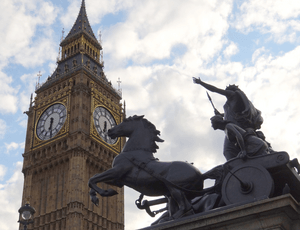Boadicea and Her Daughters facts for kids
Quick facts for kids Boadicea and Her Daughters |
|
|---|---|

The sculptural group in 2013
|
|
| Artist | Thomas Thornycroft |
| Year | 1856–1883 (executed); June 1902 (erected) |
| Type | Sculptural group |
| Medium | Bronze |
| Subject | Boudica |
| Location | London, SW1 United Kingdom |
| 51°30′04″N 0°07′26″W / 51.501097°N 0.123780°W | |
|
Listed Building – Grade II
|
|
| Official name | Boadicea (Boudicca) statuary group |
| Designated | 24 February 1958 |
| Reference no. | 1237737 |
Boadicea and Her Daughters is a large bronze statue in London. It shows Boudica, a famous queen of the Celtic Iceni tribe. She led a big fight against the Romans in Britain.
You can find this statue on the north side of Westminster Bridge. It is close to Big Ben and the Palace of Westminster. This statue is seen as the most important work by its artist, Thomas Thornycroft. He was an English artist and engineer. Thornycroft worked on the statue from 1856 until he died in 1885. His son, William Hamo Thornycroft, sometimes helped him. The statue was finally put in its spot in 1902.
Contents
What Does the Statue Look Like?
The statue shows Boudica, also known as "Boadicea" in Victorian times. She is the Queen of the Iceni tribe, who were Britons. With her are her two daughters. They are riding in a special chariot pulled by two horses standing on their back legs.
The Chariot and Its Design
The chariot in the statue is based on Roman designs. It is not like the chariots used by native British or Iceni people. Each wheel of the chariot has a sharp, scythe-like blade attached to it.
Boudica stands tall in the chariot, wearing a long dress. She holds a spear in her right hand. Her left hand is raised high. Her two daughters are crouching in the chariot, one on each side of their mother. None of them are holding the reins to guide the horses.
How Was the Statue Made?
The idea for this statue came about in the 1850s. This was after Thomas Thornycroft made a statue of Queen Victoria on a horse. That statue was shown at the Great Exhibition in 1851.
Royal Support for the Project
Queen Victoria and Prince Albert really liked Thornycroft's work. They became involved in his new project. Prince Albert wanted this huge statue to be placed over the main arch of the entrance to Hyde Park. He asked Thornycroft to create a "throne upon wheels."
People saw similarities between Queen Victoria and Boudica. Boudica's name also means "victory." Prince Albert even lent two of his horses for Thornycroft to use as models. The statue of Boudica looks a bit like a younger Queen Victoria. Sadly, Prince Albert passed away in 1861 before the statue was finished.
Funding and Casting the Statue
Thornycroft completed a full-size model of the statue before he died in 1885. However, there was no money to turn it into a bronze statue.
Later, in 1894, a mound of earth called "Boadicea's Grave" was dug up on Parliament Hill. No grave was found, but Thornycroft's son, John Isaac Thornycroft, thought this spot would be perfect for his father's statue. Still, £6,000 was needed to cast it in bronze.
A group was formed to collect money from people. By 1898, enough money was raised. The statue was cast by a company called J. W. Singer in Frome for only £2,000. But they still didn't have a place to put it.
Where Is the Statue Now?

Thornycroft's statue was not put up until 1902. This was more than 17 years after he died. It was placed at Westminster Pier in June 1902. It stands on a large granite base designed by Thomas Graham Jackson.
Inscriptions on the Plinth
Words were added to the base in 1903. The front of the base says: BOADICEA (BOUDICCA) QUEEN OF THE ICENI WHO DIED A.D. 61 AFTER LEADING HER PEOPLE AGAINST THE ROMAN INVADER.
The right side of the base has words from a poem by William Cowper called Boadicea, an ode (1782): REGIONS CAESAR NEVER KNEW THY POSTERITY SHALL SWAY.
The left side of the base explains who made and gave the statue: THIS STATUE BY THOMAS THORNYCROFT WAS PRESENTED TO LONDON BY HIS SON SIR JOHN ISAAC THORNYCROFT C.E. AND PLACED HERE BY THE LONDON COUNTY COUNCIL A.D. 1902.
Location and Importance
The statue is in a very busy spot in London. Many cars pass by on the Embankment. Lots of tourists walk past it from places like Westminster Abbey and Parliament Square. They cross the bridge towards the London Eye and Jubilee Gardens. Sometimes, a souvenir stand is in front of its base. The statue became a Grade II listed building in 1958, meaning it's an important historical structure.
See also
 In Spanish: Boudica y sus hijas para niños
In Spanish: Boudica y sus hijas para niños

